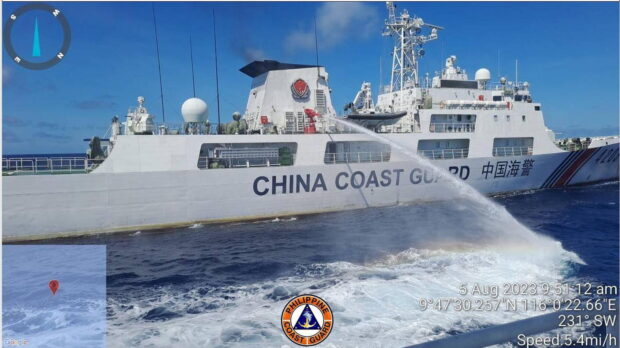Marcos says another note verbale sent to China after water cannon attack

THOSE ‘MANEUVERS’ AGAIN A China Coast Guard (CCG) ship on Saturday is seen preparing to strike a Philippine Coast Guard (PCG) vessel with a water cannon as it is on its way to Ayungin (Second Thomas) Shoal. Armed Forces of the Philippines and PCG criticized the “dangerous maneuvers,” urging CCG to “act with prudence.” (Photo from PCG FACEBOOK page)
Updated to include background and reactions from diplomats
MANILA, Philippines — President Ferdinand “Bongbong” Marcos Jr. announced on Monday another note verbale was sent to China following the water cannon attack on Philippine Coast Guard (PCG).
He also said Department of Foreign Affairs Secretary Enrique Manalo had paid the Chinese Ambassador to the Philippines, Huang Xilian, a visit to discuss the incident.
“Ang usual, ang ating Secretary of Foreign Affairs, ay pinuntahan si Ambassador Huang ngayong araw at nagdala ng isa pang note verbale, kasama na ang mga picture, mga video kung anong mga pangyayari,” Marcos said.
(Our Secretary of Foreign Affairs usually went to Ambassador Huang today and brought another note verbale, along with pictures and videos of what happened.)
Article continues after this advertisement“Titingnan natin kung ano ang kanilang magiging sagot,” said Marcos.
Article continues after this advertisement(We will see what their response will be.)
A note verbale is a diplomatic message from one government to another done through official representatives.
The President also said a command conference would take place later this afternoon (Monday) to assess how the Philippine government will respond to the recent issue with China.
“We continue to assert our sovereignty. We continue to assert our territorial rights in the face of all of these challenges, and consistent with the international law, and Unclos (United Nations Convention on the Law of the Sea) especially,” the President emphasized.
“So that has always been our stand. But we still have to keep communicating with the Chinese government,” the Commander in Chief stressed.
On Sunday, the Armed Forces of the Philippines said a CCG vessel blocked and fired a water cannon on a PCG boat on a resupply mission “in wanton disregard of the safety of the people on board and in violation of international law.”
Countries react
A photograph released by diplomatic sources showed another CCG vessel striking a Philippine Navy boat with a water cannon.
Countries that slammed China for the latest harassment:
– Japan, through Japanese Ambassador Kazuhiko Koshikawa, said any harassment and actions that infringed on lawful activities of the sea and endangered navigational safety were “totally unacceptable.”
– Canada which said it “unreservedly” condemned CCG’s “dangerous and provocative actions” against Philippine vessels
– The British Embassy in Manila said China’s action “poses serious risks to regional peace and stability”
– Australia expressed concern over the CCG’s “dangerous and destabilizing” actions
– EU Ambassador to the Philippines Luc Veron said the bloc “stands with the [Philippines] in upholding the rules-based international order” and “supports the legally binding nature of the 2016 South China Sea arbitration”
Past incidents
The Philippines, in 2016, won the case it filed against China before the Permanent Court of Arbitration in the Hague, which upheld the Philippines’ EEZ under Unclos and rebuffed China’s sweeping claims over the entire South China Sea, including Ayungin Shoal and other areas within the West Philippine Sea.
Ayungin is a low-tide elevation atoll. It is 194 kilometers off Palawan province and 37 km northwest of Panganiban (Mischief) Reef, part of the Philippines’ EEZ, which China grabbed in 1995. From then on, it was transformed into a vast military outpost that could launch missiles.
Navy vessels send resupply to the country’s eight outposts in the West Philippine Sea. To avoid tensions that the presence of gray ships might cause, wooden boats were used to supply troops guarding the Ayungin.
RELATED STORIES:
US, allies slam China for firing water cannons on PH vessels
US: China’s water cannon attack in WPS ‘threatening regional peace and stability’